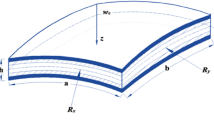Abstract
The current study presents a finite element model of mitral leaflet tissue, which incorporates the anisotropic material response and approximates the layered structure. First, continuum mechanics and the theory of layered composites are used to develop an analytical representation of membrane stress in the leaflet material. This is done with an existing anisotropic constitutive law from literature. Then, the concept is implemented in a finite element (FE) model by overlapping and merging two layers of transversely isotropic membrane elements in LS-DYNA, which homogenizes the response. The FE model is then used to simulate various biaxial extension tests and out-of-plane pressure loading. Both the analytical and FE model show good agreement with experimental biaxial extension data, and show good mutual agreement. This confirms that the layered composite approximation presented in the current study is able to capture the exponential stiffening seen in both the circumferential and radial directions of mitral leaflets.







Similar content being viewed by others
References
Billiar KL, Sacks MS (2000) Biaxial mechanical properties of the native and glutaraldehyde-treated aortic valve cusp: part II—a structural constitutive model. J Biomech Eng 122(4):327–335
Dal Pan F, Donzella G, Fucci C, Schreiber M (2005) Structural effects of an innovative surgical technique to repair heart valve defects. J Biomech 38:2460–2471
Einstein D, Reinhall P, Nicosia M, Cochran R, Kunzelman K (2003) Dynamic finite element implementation of nonlinear, anisotropic hyperelastic biological membranes. Comput Meth Biomech Biomed Eng 6(1):33–44
Einstein DR, Kunzelman KS, Reinhall PG, Nicosia MA, Cochran RP (2004) Haemodynamic determinants of the mitral valve closure sound: a finite element study. Med Biol Eng Comput 42(6):832–846
Grande-Allen KJ, Liao J (2011) The heterogeneous biomechanics and mechanobiology of the mitral valve: implications for tissue engineering. Curr Cardiol Rep 13:113–120
Halquist JO (2006) LS-DYNA theory manual. http://www.dynasupport.com/manuals
Hinton RB, Yutzey KE (2011) Heart valve structure and function in development and disease. Ann Rev Physiol 73:29–46
Kunzelman KS, Cochran RP (1992) Stress/strain characteristics of porcine mitral valve tissue: parallel versus perpendicular collagen orientation. J Cardiac Surg 7(1):71–78
Kunzelman KS, Cochran RP, Murphree SS, Ring WS, Verrier ED, Eberhart RC (1993) Differential collagen distribution in the mitral valve and its influence on biomechanical behaviour. J Heart Valve Dis 2:236–244
Kunzelman K, Reimink MS, Verrier ED, Cochran RP (1996) Replacement of mitral valve posterior chordae tendineae with expanded polytetrafluoroethylene suture: a finite element study. J Cardiac Surg 11(2):136–145
Kunzelman KS, Einstein DR, Cochran RP (2007) Fluid-structure interaction models of the mitral valve: function in normal and pathological states. Philos Trans R Soc B 362:1393–1406
Maisano F, Redaelli A, Soncini M, Votta E, Arcobasso L, Alfieri O (2005) An annular prosthesis for the treatment of functional mitral regurgitation: finite element model analysis of a dog bone-shaped ring prosthesis. Ann Thorac Surg 79(4):1268–1275
May-Newman K, Yin FCP (1998) A constitutive law for mitral valve tissue. J Biomech Eng 120(1):38–47
Prot V, Skallerud B (2009) Nonlinear solid finite element analysis of mitral valves with heterogeneous leaflet layers. Comput Mech 43(3):353–368
Prot V, Skallerud B, Holzapfel GA (2007) Transversely isotropic membrane shells with application to mitral valve mechanics. Constitutive modelling and finite element implementation. Int J Numer Meth Eng 71(8):987–1008
Qu J, Cherkaoui M (2006) Fundamentals of micromechanics of solids. Wiley, Hoboken, pp 226–240
Quapp KM, Weiss JA (1998) Material characterization of human medial collateral ligament. J Biomech Eng 120(6):757–763
Skallerud B, Prot V, Nordrum IS (2011) Modeling active muscle contraction in mitral valve leaflets during systole: a first approach. Biomech Model Mechanobiol 10:11–26
Weinberg EJ, Kaazempur-Mofrad MR (2006) A large-strain finite element formulation for biological tissues with application to mitral valve leaflet tissue mechanics. J Biomech 39(8):1557–1561
Weinberg EJ, Mofrad MRK (2007) A finite shell element for heart mitral valve leaflet mechanics, with large deformations and 3D constitutive material model. J Biomech 40(3):705–711
Wenk JF, Zhang Z, Cheng G, Malhotra D, Acevedo-Bolton G, Burger M, Suzuki T, Saloner DA, Wallace AW, Guccione JM, Ratcliffe MB (2010) First finite element model of the left ventricle with mitral valve: insights into ischemic mitral regurgitation. Ann Thorac Surg 89(5):1546–1553
Zohdi TI (2003) Genetic design of solids possessing a random-particulate microstructure. Philos Trans R Soc London, Ser A 361(1806):1021–1043
Acknowledgments
This study was supported by NIH grants R01-HL-84431 (Dr. Ratcliffe), R01-HL-63348 (Dr. Ratcliffe), R01-HL-77921 (Dr. Guccione), and R01-HL-86400 (Dr. Guccione). This support is gratefully acknowledged. We would like to thank Mike Burger and Nielen Stander at LSTC for their insights.
Author information
Authors and Affiliations
Corresponding author
Rights and permissions
About this article
Cite this article
Wenk, J.F., Ratcliffe, M.B. & Guccione, J.M. Finite element modeling of mitral leaflet tissue using a layered shell approximation. Med Biol Eng Comput 50, 1071–1079 (2012). https://doi.org/10.1007/s11517-012-0952-2
Received:
Accepted:
Published:
Issue Date:
DOI: https://doi.org/10.1007/s11517-012-0952-2




